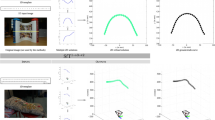Abstract
This article addresses the problem of recognizing a solid bounded by a smooth surface in a single image. The proposed approach is based on a new representation for two- and three-dimensional shapes, called their signature, that exploits the close relationship between the dual of a surface and the dual of its silhouette in weak-perspective images. Objects are modeled by rotating them in front of a camera without any knowledge of or constraints on their motion. The signatures of their silhouettes are concatenated into a single object signature. To recognize an object from novel viewpoint other than those used during modeling, the signature of the contours extracted from a test photograph is matched to the signatures of all modeled objects signatures. This approach has been implemented, and recognition examples are presented.
Similar content being viewed by others
References
Arbogast, E. and Mohr, R. 1991. 3D structure inference from image sequences. Journal of Pattern Recognition and Artificial Intelligence, 5(5):749.
Boyer, E. and Berger, M. 1997. 3D surface reconstruction using occluding contours. Int. J. Computer Vision, 22(3):219–233.
Bruce, J. and Giblin, P. 1992. Curves and Singularities. Cambridge University Press.
Cipolla, R., Aström, K., and Giblin, P. 1995. Motion from the frontier of curved surfaces. In Int. Conf. on Computer Vision, pp. 269–275.
Cipolla, R. and Blake, A. 1992. Surface shape from the deformation of the apparent contour. Int. J. Computer Vision, 9(2):83–112.
Cipolla, R. and Giblin, P. 2000.Visual Motion of Curves and Surfaces. Cambridge University Press: Cambridge.
Forsyth, D. and Ponce, J. 2002. Computer Vision: A Modern Approach. Prentice Hall.
Giblin, P. and Weiss, R. 1995. Epipolar curves on surfaces. Image and Vision Computing, 13(1):33–44.
Glachet, R., Dhome, M., and Lapersté, J. 1991. Finding the perspective projection of an axis of revolution. Pattern Recognition Letters, 12:693–700.
Huttenlocher, D. and Ullman, S. 1987. Object recognition using alignment. In Int. Conf. on Computer Vision. London, U.K., pp. 102–111.
Joshi, T., Vijayakumar, B., and Kriegman, D. 1997. HOT curves for modeling and recognition of smooth curved 3D objects. Image and Vision Computing, 15(7):479–498.
Kergosien, Y.L. 1981. La famille des projections orthogonales d'une surface et ses singularités. C.R. Acad. Sc. Paris, 292:929–932.
Koenderink, J.J. 1984. What does the occluding contour tell us about solid shape?. Perception, 13:321–330.
Koenderink, J.J. and Van Doorn, A.J. 1976. The singularities of the visual mapping. Biological Cybernetics, 24:51–59.
Kriegman, D. and Ponce, J. 1990a. On recognizing and positioning curved 3D objects from image contours. IEEE Trans. Pattern Anal. Mach. Intelligence, 12(12):1127–1137.
Kriegman, D.J. and Ponce, J. 1990b. Computing exact aspect graphs of curved objects: Solids of revolution. Int. J. Computer Vision, 5(2):119–135.
Liu, J., Mundy, J., Forsyth, D., Zisserman, A., and Rothwell, C. 1993. Efficient recognition of rotationally symmetric surfaces and straight homogeneous generalized cylinders. In Proc. IEEE Conf. on Comp. Vision and Patt. Recog. New York City, NY, pp. 123–128.
Lockwood, E.H. 1967. Pedal curves. In A Book of Curves. Cambridge University Press: Cambridge, England, pp. 152–155.
Lowe, D.G. 1987. The viewpoint consistency constraint. Int. J. Computer Vision, 1(1):57–72.
Maclaurin, C. 1718. Tractatus de Curvarum Constructione & Mensura. Philosophical Transactions, 30(356):803–812.
Murase, H. and Nayar, S. 1995. Visual learning and recognition of 3-d objects from appearance. Int. J. Computer Vision, 14(1):5–24.
Ponce, J. and Chelberg, D. 1987. Finding the limbs and cusps of generalized cylinders. Int. J. Computer Vision, 1(3):195–210.
Ponce, J., Hoogs, A., and Kriegman, D. 1992. On using CAD models to compute the pose of curved 3D objects. CVGIP: Image Understanding, 55(2):184–197.
Renaudie, D., Kriegman, D., and Ponce, J. 2000. Duals, invariants, and the recognition of smooth objects from their occluding contour. In Proc. European Conf. on Computer Vision, vol. 1, pp. 784–798.
Richetin, M., Dhome, M., Lapresté, J., and Rives, G. 1991. Inverse perspective transform from zero-curvature curve points: Application to the localization of some generalized cylinders from a single view. IEEE Trans. Pattern Anal. Mach. Intelligence, 13(2):185–191.
Sullivan, S. and Ponce, J. 1998. Automatic model construction, pose estimation, and object recognition from photographs using triangular splines. IEEE Trans. Pattern Anal. Mach. Intelligence, 20(10):1091–1096.
Torr, P. and Zisserman, A. 2000. MLESAC: A new robust estimator with application to estimating image geometry. CVIU, 78(1):138–156.
Vaillant, R. and Faugeras, O. 1992. Using extremal boundaries for 3D object modeling. IEEE Trans. Pattern Anal. Mach. Intelligence, 14(2):157–173.
Vijayakumar, B., Kriegman, D., and Ponce, J. 1998. Invariantbased recognition of complex curved 3-D objects from image contours. Computer Vision and Image Understanding, pp. 287–303.
Zeroug, M. and Medioni, G. 1995. The challenge of generic object recognition. In Object Representation for Computer Vision, M. Hebert, J. Ponce, T. Boult, and A. Gross (Eds.). Springer-Verlag, pp. 271–232.
Author information
Authors and Affiliations
Rights and permissions
About this article
Cite this article
Sethi, A., Renaudie, D., Kriegman, D. et al. Curve and Surface Duals and the Recognition of Curved 3D Objects from their Silhouettes. International Journal of Computer Vision 58, 73–86 (2004). https://doi.org/10.1023/B:VISI.0000016148.08046.fc
Issue Date:
DOI: https://doi.org/10.1023/B:VISI.0000016148.08046.fc




